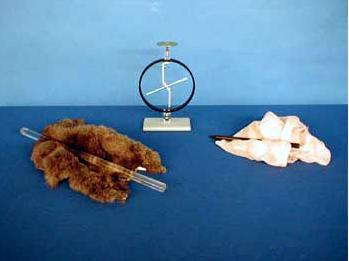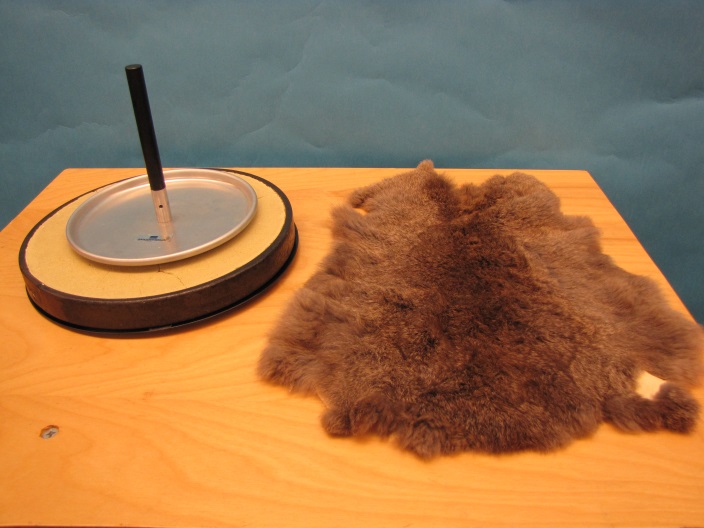Demos: 5A-01 Static Electricity


A variety of materials is available for producing charges on insulators by rubbing different materials together. The evidence for charge can be shown using an electroscope.
Directions: Note: Because the production of charged materials is greatly affected by humidity, the equipment is stored in a portable oven. For best results, especially on humid days, leave the objects in the oven until ready for use.
First, remove the hard rubber rod and the rabbit fur from the oven. Holding the rod in one hand, rub it vigorously with the fur. This will produce a negative charge on the rubber rod.
Do the same thing with the glass rod and silk cloth. A positive charge will be produced on the glass rod.
Test each for charge by bringing the rod close to the electroscope. (At this point you have no way of knowing the sign of each charge. The electroscope is merely a detector of charge.)
Another method of producing charge is using the electrophorus and charging it by induction. Take the rabbit fur and rub it on the small sheet of acrylic plastic. Take the electrophorus and place it on the acrylic sheet. Touch the metal portion with your finger (ground it). Remove your finger and pick up the electrophorus by the insulated handle. You will now have a net positive charge on the electrophorus.
Suggestions for Presentation: The conceptual danger in this set of demonstrations is in assuming too much from the observations. By the usual definitions of charge, we can show that the rods are charged, but how this happens and the signs of the charges cannot be inferred from the observations. And if you are doing Demonstration 5A - 02 at the same time, you can explain how the electroscope works, but initially it is necessary only to call the electroscope a charge detector. Although the electroscope can’t determine the sign of the charge, it can be used to detect charge opposites. For example, suppose you transfer charge to the electroscope by stroking the knob on the electroscope with the charged rubber rod. The leaf (or movable vane) will stand out. If the charged glass rod is then brought near the electroscope, the vane will start to collapse. [Note: If conditions are right, you MIGHT be able to bring the fur up near the electroscope and cause it to collapse, showing that the fur has a charge opposite to that of the rubber rod.]
Another demonstration can be performed easily and it’s one that students can do in their rooms. Take a piece of Magic Mending Tape about eight inches long and firmly press it down on the lecture desk. Take another piece the same size (turn under a small portion to create a “handle”) and stick it firmly to the first one. Take the handle and pull the top tape off rapidly. Bringing your hand near will cause the tape to be attracted to your hand, indicating that the tape is charged. (See Sherwood* for details)
Please note: Be careful that you not stress too strongly the electron transfer nature of the charging process. According to Sherwood*, evidence seems to indicate that the majority of charge transfers involve organic molecules that are easily broken in the friction process. Thus, it is molecular ions, not electron transfer that account for the bulk of the charge transfers.
Also, a variety of texts attempt to predict the sign of charges when certain combinations of materials are rubbed together (e.g. plastic bag on ruler), but these are ideal--contaminants, which are largely organic molecules, can change the outcome. For that reason, it is best to focus on like charges and opposite charges rather than the actual signs of the charge.
Applications: Copier machines, electrostatic painting, to name a few.
*Sherwood and Chabray, “Electromagnetic Interactions”, 1995, Chapter 1 (Copy in Room 144)